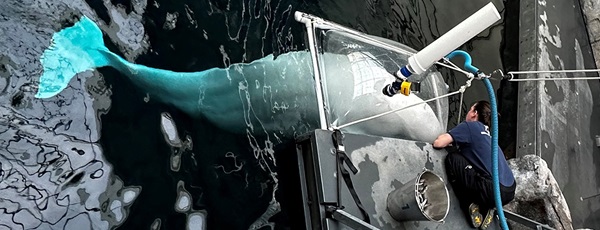Hunting in the North Sea, harbour seals often encounter murky water that impedes their vision; but it doesn't affect their ability to chase prey. Extending their vibration-sensitive whiskers, the mammals are almost as efficient at pursuing their quarry as they would be if guided by sight. Wolf Hanke and his colleagues from the University of Rostock, Germany, are fascinated by how harbour seals perceive the world through their flow-sensitive vibrissae. Having already found that seals can pick up and follow fish wakes up to 35 s after the prey has passed and knowing that a fish's size and shape can dramatically affect its wake structure, graduate student Sven Wieskotten decided to find out how well seals can distinguish between the wakes of objects with different shapes and sizes (p. 1922).
Teaming up with Henry the harbour seal at the Marine Science Centre, Germany, Hanke, Wieskotten and their colleagues, Lars Miersch and Guido Dehnhardt, began testing Henry's ability to distinguish between the wakes of differently sized paddles. The researchers blindfolded Henry and covered his ears, then they swept a paddle through a large box in Henry's enclosure and allowed him to enter it 3 s later. Having trained Henry to press a target outside the enclosure when he recognised the wake of a standard paddle and to press a different target when he recognised the wake from a larger or smaller paddle, the team found that Henry could distinguish between paddles that differed by as little as 2.8 cm in width.
Then, the team tested which aspects of the wake the seal picked up on. ‘We randomised the speeds of the paddles so that the maximum flow velocity wasn't a distinguishing cue for the widest paddles, but the structure of the wake had to be recognised by the seal and he could do that too, but with slightly less accuracy,’ remembers Hanke.
Next, the team varied the paddle shapes and asked Henry to distinguish between the wakes of triangular, cylindrical, flat and undulating paddles. The seal successfully distinguished between the flat and cylindrical paddles, the flat and undulating paddles and the undulating and cylindrical paddles after they were swept through the enclosure. However, he had problems distinguishing the triangular paddle from the undulating or cylindrical shapes.
Having found that Henry can distinguish between the wakes of different passing objects and investigated the structure of each paddle's wake with digital particle image velocimetry, Hanke says, ‘It is difficult to tell which part of the wake serves the animal most and which aided only a little.’ So, Hanke is keen to test Henry's responses to single vortices to find out which wake components might give a fish's size and shape away. He explains that hunting seals have to optimise the amount of energy that they ingest while hunting so, if a seal can distinguish between small skinny fish – which cost too much to pursue – and the perfect lunch based on their wakes alone, that could improve its hunting efficiency enormously.








